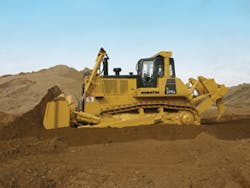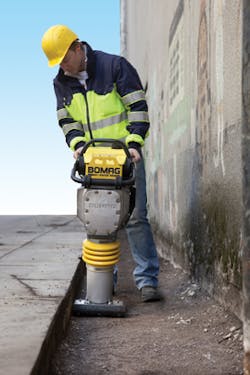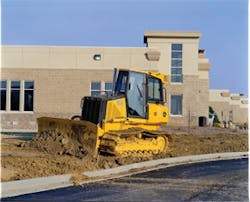Many readers may not remember asking the telephone operator for help. When we couldn’t get the call result we wanted, we asked the operator and she (it was usually a lady) set us in the right direction. We in our dotage will remember that Jim Croce had a hit single with that operator theme. There was nothing wrong with our telephone; it just needed the right person to make it work perfectly. Of all the machines used by contractors, dozers and compactors may be the ones that require the most operational skill. It’s a human skill that welcomes all the technological innovations of today’s machines and puts those advances to their most efficient use. The operator could be older and experienced, or young and fresh to the work; the operator could be male or female, Caucasian or Hispanic, short or tall, muscular or skinny, but there’s a magical skill there that makes everything happen as it should. I have seen an 18-year-old straight from high school operate a dozer with more skill than his much more experienced boss. Why? Who knows? The boss recognized the talent and was not in the least annoyed. After all, young Ryan took one pass to achieve what his boss did in two or more. “Jealous? I wish I’d had his natural skill and ground knowledge when I was his age,” was the old man’s smiling comment.
Let’s start with compaction. Compaction is not simply the job of smashing something heavy down on the soil to make it look flat, nor is it rolling quickly across fresh asphalt so that it’s more-or-less-flat. Standards have changed over the years, specifications have become stricter, and our projects have benefited from the superior results. Most people think of asphalt when you mention a compactor, but let’s start with the more basic technique: soil compaction. The compacting machine can be big, with heavy rollers or several wheels, or it can be a tool that one person holds and uses—on the base for a sidewalk, for example, or the path that goes from the hospital’s main entrance to the extended care building, or down in the trench on Bell Street.
It’s all About Soil
Below the compactor is soil. Below every construction is soil. What we dig, what we grade, what we compact is soil. Soil is not a consistent material, and the efficiency of compaction probably depends much more on the nature of that soil and the operator’s understanding of its features than on the size or weight (or published “impact force”) of the compacting machine. On some soils, even the largest compactor does not work well if it was chosen simply for its size. Knowing the soil, then, is vitally important in any compaction project, and there are specifications about machines that seem thorough and expert but which are somewhat misleading in what they say or imply. Some of the words you find in the specs for rammers, for example, will include such terms as amplitude, stroke, impact force, total applied force, centrifugal force, area of compaction, depth of compaction, weight, and travel speed. More important than any of those features is your knowledge of the soil you intend to compact. Whether it is a trench to hold pipe, a hole excavated to accommodate the basement for a new house, the massive area to support a nuclear power station, the ground is soil and it is the nature of that soil that will determine how we compact it…and rely on its compacted strength for future stability.
The number of passes depends on such conditions as gradation, moisture, and depth of lift.
I saw some interesting words on this subject recently and would like to credit Frank Multerer, president of MBW Inc., makers of well-received compaction equipment, with the helpfulness of these observations. “Too much attention is focused on performance specifications, too little attention given to good compaction practice,” advises Multerer. “The reality is that how hard the hardest hitting compactor ‘hits’ is irrelevant when the conditions of compaction control whether or not geotechnical objectives can be met. Attention should be focused on what is relevant, compaction protocol, and conditions of compaction. We at MBW divide backfill soils into two broad categories: essentially granular soil (soil with fines content not greater than 20%) and essentially cohesive soil (soil with a fines content greater than 20%). After identifying those two broad categories of soil, we apply appropriate lift protocol. Essentially, granular soil lifts should not exceed 12 inches in depth, regardless of the size of the compactor to be used. Essentially cohesive lifts should not exceed 9 inches, and you should give special attention to whether or not moisture is in the workable range. Soil moisture content tends to be less of a problem with essentially granular soils, due to their wide and forgiving workable moisture range. Typically, an essentially granular soil can be compacted to specified goal from standard Proctor optimum moisture to 75% dry of that number. When significantly dry of optimum, however, the number of passes required to achieve geotechnical goals may increase significantly.”
Some experienced contractors test by hand to see if granular soils are in a workable moisture range. If you are working with cohesive soils, those same contractors discourage the use of hand testing because of the likelihood of error when the range is so narrow. MBW recommends an agricultural moisture gauge to determine the moisture content in cohesive soils. You push the gauge’s probe into the soil and a digital readout is given for moisture content. In agriculture the moisture is measured by volume, whereas we measure by weight in construction, so divide the volume readout of the agricultural gauge by two to get a good approximation in weight. That’s not a perfect measurement but you can get it easily, at low cost, and it will reduce the number of errors you get from hand testing.
Here’s a final caution on soil compaction practices. “The number of passes made with a plate, rammer or roller over a lift of soil should never be specified,” adds Multerer. “The number of passes depends on conditions of compaction such as soil gradation, moisture content, and depth of lift. In an independent study by the University of Massachusetts, it was found that heavy vibratory rollers (up to 25,000 pounds) achieved passing nuclear densitometer and sand cone results on 12-inch lifts of highway-grade granular backfill after two passes early in the day, six to eight passes at midday, and up to 14 passes in late afternoon. The variable was the decreasing soil moisture content as the day went by.” It was not the make of compactor, not its travel speed, weight, or measurements…just normal, daily weather changes.
Compacting Asphalt
What is under the asphalt the public sees? Start at the bottom. There is the subgrade, known as the earth, soil, or ground, on which everything else is built. It could be an embankment or a fairly flat stretch prepared initially by dozers, graders, scrapers, and excavators. Above the subgrade is what may be called a capping layer, still mostly soil. Above that comes the subbase, then the asphalt base course, the asphalt binder course, and, on top, the asphalt wearing course. If any one of those layers is weak or misshapen, it will affect the whole structure, including the top on which we run our vehicles. The names of each layer may vary. I have taken mine from a paper by Bomag, one of the most experienced and respected manufacturers of compacting equipment and one which has done an amazing amount of research into the whole compaction process. The Bomag paper on compaction is downloadable, easy to read, comprehensive, and presented in such a way that the paper would be a useful reference for everybody involved in compaction.
It’s the operator who keeps the dozer accurate and safe on ground that could be hazardous to the incompetent.
Poor compaction practice causes uneven, broken-up roads and streets, dangerously unstable ground above pipes essential to infrastructure, and cracks in the foundations of buildings that may be quite perfect otherwise. Whether it is a road or a building, nothing is much good if the structure has insufficient strength and fails.
Moisture plays an important role in compaction because its presence in soil can be helpful or ruinous. Most of us have mixed concrete, at home or at work, and can appreciate that too much moisture in the mixture will produce an unsatisfactory concrete mixture; too little moisture will be bad, too. Soil is the same. When there is too little moisture in the soil, the density is low and there is a lot of friction. When the moisture is high, the density is still low and the pressure of the water on everything else is too much for satisfactory compaction results. So we need good moisture content in the soil, because that allows us to compact most efficiently and gain the maximum density. We must measure the moisture content. Find out about the Proctor test, for example, to see if you can do it yourself or need to get somebody else (more qualified in soil engineering) to do it.
The aggregates and backfill that we meet most often are described as coarse aggregate (sand and gravel), fine aggregate (clay and silt), and rockfill (boulders and cobbles). Rockfill is what you use for dams, embankments, and some foundations. You would use heavy, single-drum rollers or heavy plates for compaction of rockfill. It’s a material that demands high-compaction energy. On those thousands of smaller compaction jobs, like trenches and backfilling after infrastructure repairs downtown, the fine aggregate of silt and clay is frequently met. Because of its cohesive nature, it’s not as easy to compact as it seems. The effectiveness of the compaction will depend on the moisture content. In most of those small projects, trench compactors and heavy plates are used. For bigger projects, you’ll be considering a medium-size single-drum roller, a heavy roller, and perhaps a padfoot drum on the roller.
Much of our compaction is for sub-bases and bases for streets, roads, airports, and building foundations. The aggregate is often a mixture of sand and gravel and the rollers often preferred are single-drum rollers with smooth drums or vibratory tandem rollers. It’s straightforward compaction, but you should be aware that too much compaction of these bases can be as harmful as not enough. It is most important to understand and follow the compaction instructions for these everyday projects. The collapse or deterioration of a road can be caused by incorrect compaction below the asphalt that everybody sees.
Before proceeding with more technical words, I should mention some sources for compaction equipment, and remind you that manufacturers are excellent sources for practical information about performance and techniques. Some of these companies are well known to you; others may be newcomers. Ask advice and questions from Bomag, MBW, Sakai, Caterpillar, JCB, Lee Boy, Volvo, Ammann, Dynapac, Hamm, Atlas Weyhausen, MQ (MultiQuip), Belle, Weiba, Liu Gong, SCNK, Intensus, Sinoway, Vibrotech, Wacker Neuson, Weber, and Stone Construction Equipment. Some of them offer compaction equipment for everything, while others specialize in streets, parking lots, roads, and highways. Some are specialists in the smaller walk-behind rammers and tampers for the soil under sidewalks, trenches, and paths. They could all give good advice on the right power and pressure for the right results. Let me finish this section on compaction by saying that some of the equipment makers have onboard devices and styles of compaction (like vibrating rollers as opposed to smooth drums for static compaction) that make the work easier, but the operator is still vitally important. The choice is huge; it simply takes some homework to decide which is the best for your particular applications and personnel.
Dozing to Different Drummers
If you asked 25 dozer operators for the single most valuable talent required for excellence in performance, you would get 20 or more different answers. Whatever the variations in specifics, there is one talent that is almost taken for granted: The operator knows the machine and knows what it can and cannot do. That knowledge comes from learning about the machine before ever starting it. If it’s a new dozer and you are used to dozers made 10 or 15 years ago, learn (and appreciate) how much simpler everything is to control. Simpler, yes, but you still have to do it the right way.
What do you use a dozer for? Do you just push earth? Or do you move the earth to prepare a building site but also clear brush and rubble, dress slopes, cut ditches, position the backfill around foundations? The simplest definition of a dozer is that it is an engine and a blade. That does not tell half the story. One operator told me that the most difficult part of running a dozer is not running it. “Anybody can turn on the engine and drive the dozer forward,” he commented. “It’s when you have to turn the machine and follow a definite pattern, without smashing adjacent structures en route, that it gets difficult. We recommend that everybody who is going to use a dozer has some good practice on rough ground where there is no danger of destroying the neighborhood or tipping over into disaster.” In recent years there have been systems to mount on dozers that make them beautifully accurate, but the operator must learn how to use them correctly. There’s some learning involved—and attitude.
A principal reason for giving the D51, D31, and D37 that super-slant design was not merely because Komatsu wanted the dozers to look nice. The slant nose with the new cab-forward design puts the operator closer to the blade while it improves the balance, ride, and stability. The design is to help the operator, that human key to success. “Slanting the nose and moving operators forward allows them a better view all around,” advises Bruce Boebel, Komatsu dozer product manager. “It gives them a great view of the material they’re pushing. The cabs are larger than their predecessors, with more glass to enhance visibility, making the operator more efficient. Owners can put new operators in these machines and be confident they will learn how to run a dozer faster, so they’re productive more quickly.”
Let’s ask the question again. What are you going to do with your dozer (or track-type tractor)? If you look at the machines in the range of, say, Caterpillar, you’ll find that they have designed dozers for particular kinds of projects. Some of the machines are quite small; some are huge. If your projects are big—earthmoving by the acre, as it were—you’ll be looking at the Cat D8T, D9T, D10T, or D11T, all of them engineered for the toughest dozing. Their operating weights range from 84,850 pounds to 230,581 pounds. You wouldn’t use them for small projects like single residential construction. You’d choose a D3K, D4K, or D5K for that work, to clear and grade the lot before building, to slope the sides of roads, for backfilling, and even for landscaping and driveway construction. Their power is usually less than 100 horsepower. You can see how important a competent operator is for such work—all at the same site—and there are thousands nationwide who do it well. You will also find that the best operators nationwide know the soil or earth which they moving. The middle range dozers (or track-type tractors) are like the D6K, D6N, and D6T from Caterpillar. These are the dozers you expect to see, because they are neither huge nor small, and they cope with many of the daily dozing tasks we have. They have the reputation of responding to the operator’s needs quickly and powerfully…it really helps if the operator knows what to expect and how to achieve what he wants.
One type of dozer that has garnered praise from operators in recent years is the 764HSD from John Deere. (HSD stands for high-speed drive.) It’s that dozer that looks as if it has a set of triangular tracks instead of the usual shapes, and it is that design that has prompted operators to welcome the improved suspension created. It’s definitely better than a rigid frame, they say, even when you are running the machine at full power to get the best from the GPS system included. This dozer was developed when the manufacturer discovered that many contractors were using dozers to do finish work (instead of graders, often) as well as their “usual” earthmoving. It takes time to get used to new techniques required for the best operation of this type of dozer, but good operators know that and they have produced some excellent results quite quickly after their first acquaintance. The difference between the track system (from Camoplast) on this Deere dozer and, say, a compact track loader is that every time you turn with the 764HSD you don’t push material into the track system to wear on the track components, because it articulates.
Our manufacturers keep making compaction and dozing equipment more accurate, more reliable, and easier to operate. It’s unlikely that any of us will see everyday use of a dozer or compactor that does everything by itself. One reason for that is the requirement that the operator of the machine (whether it’s a person or a computer) will always have to know the nature of the earth to be moved. Thank heavens we have thousands of great operators nationwide. If there is a serious anxiety in this area, it’s wondering where tomorrow’s good operators are coming from.











